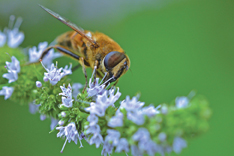
July 2021
Dear EarthTalk: What are some quick and easy ways to make my home more comfortable and climate-friendly? ~ Jane B., Tampa, FL
While the coronavirus pandemic has been a serous blight on the world, we’ve all learned valuable lessons about resource consumption from running around so much less. The lack of commuting has practically emptied the roads, helping temporarily reduce carbon emissions. But all the lockdown time has also made us painfully aware of the shortcomings of our homes. Now may well be an excellent time to make improvements that will benefit not only the environment but also your residential bottom line.
One key place to start is weatherizing. If your home is drafty, you may be consuming as much as 20 percent more energy than you need to keep the inside temperature to your liking.
“One simple way to hunt for indoor leaks is to slowly move an incense stick along floors, windows, doors, vents, and walls, and look for places where the smoke changes direction rather than rising straight up,” says Daisy Simmons of Yale Climate Connections. “Jot down the trouble spots, then address them…with either weather-stripping or caulking, depending on the location.” Outlets and switches, she adds, are often draft culprits, but can be sealed easily with cheap foam gaskets from the hardware store.
Beyond remediating individual drafts, adding insulation in general (to the walls, floors, ceilings, basements and crawl spaces) can boost household energy efficiency by some 10 percent on average according to the federal government’s EnergySTAR program to promote efficient appliances and building systems. Indeed, 90 percent of homes in the U.S. are under-insulated, leaving residents vulnerable to temperature swings (cold snaps, heat waves) not to mention noise, humidity and other external negatives.

Another way to reduce your impact and carbon footprint is to cut back on the amount of garbage your household generates. Zero waste home guru and author Bea Johnson says cutting out landfill-bound trash is all about the discipline to follow five simple rules: Refuse what you don’t need (like freebies and junk mail), let go of what you don’t use or need in your home (boosting the all-important waste-busting “second-hand market”), reuse, recycle and compost. Her family has been able to reduce their annual landfill-bound waste to a few pieces of plastic and other debris that can fit into a small jar, and saves lots of money along the way. Johnson reports shaving about 40 percent off her overall family budget thanks to going zero waste.
There are tons of other ways to reduce your carbon footprint and overall environmental impact at home. Switch to cold water in the clothes washer and avoid the dryer as much as possible in favor of line-drying. Swap incandescent and even CFL light-bulbs for more efficient LEDs. Get a programmable thermostat that you can set to turn down overnight or when you’re not home. Upgrade curtains and blinds to help insulate and keep your home comfortable no matter the weather outside. With so many ways to green up your household and residential lifestyle, the hardest part might just be deciding where to start.
CONTACTS: “Tips: How to weatherize your home;” yaleclimateconnections.org/2021/06/tips-how-to-weatherize-your-home/; “This Jar Represents One Family’s Waste For An Entire Year,” https://www.wbur.org/hereandnow/2019/05/20/zero-waste-family.
Dear EarthTalk: What is a “pollinator lawn” and how can I make one in my backyard? ~ Jane W., Westbrook, CT
Bees and other pollinators are essential for growing a great deal of nature’s finest foods. These include coffee, chocolate, beans, many fruits including apples, avocados, blueberries, cherries and peaches, nuts like almonds and cashews, and vegetables such as cauliflower, broccoli and Brussel’s sprouts, just to name a few. More than 100 U.S.-grown crops rely on pollinators. Small birds and animals also depend on a variety of pollinated wild fruits and seeds to survive.
Unfortunately, the populations of bees and other pollinators, including hummingbirds, butterflies, moths and flies, have been drastically declining due in part to exposure to insecticides, but also to loss of natural habitat including grasslands, meadows and woodlands lost to human development.

Turning your own lawn into a pollinator or “bee” lawn can help restore the kinds of natural habitat no longer available to pollinators. Typical manicured lawns, which require a great deal of water, gas for mowing and weed-killer, are also a virtual desert environment for bees and other pollinators. In contrast, “bee” lawns consist of a mix of grasses and shorter flowers that can provide vital nutrition to pollinators. Fine fescues grass, for example, has thin blades that give flowers the best chance to grow, and shorter perennial flowers such as Dutch White Clover, Creeping Thyme and Self-Heal cater to a variety of bees with diverse pollen and nectar needs. Dutch White Clover flowers also take nitrogen from the air and add it back into soil, reducing the need for fertilizer. It’s recommended that bee lawns be kept at least three inches tall to provide a shaded, moist environment for flowers to bloom and seeds to form.
Furthermore, incorporating a very simple bee water garden into a bee lawn can provide pollinators with a shallow water source that can be otherwise difficult to find. Because bees are small and can easily drown, bee water gardens consist of wide, shallow bowls of water that have rocks rising above the water surface for bees to stand on. And for anyone worried about being stung on their bee lawn, it’s good to know that wild bees do not sting when foraging for flower nectar or pollen—in fact, you can safely get within inches of bees visiting flowers and not get stung. People usually tend to get stung only when bees are harassed at their nest, stepped on or entangled in pieces of clothing.
Thankfully, the importance of bee lawns has been gaining momentum, so much so that, in 2019 Minnesota launched the $900,000 Lawns to Legumes project to help homeowners across the state make their lawns bee-friendly. The program particularly emphasizes hope for providing protection for the at-risk rusty patched bumblebee, Minnesota’s state bee. At one time abundant, the rusty patched bumblebee has suffered an 87 percent decline in population in the last 20 years and was formally listed as federally endangered in March 2017, marking the first bee in the continental U.S. to make the endangered species list.
CONTACTS: “Why Planting a Bee Garden Is Good for Pollinators, Good for the Planet, and Good for You!” https://medium.com/climate-conscious/why-planting-a-bee-garden-is-good-for-pollinators-good-for-the-planet-and-good-for-you-100de8a228e2; Lawns to Legumes, http://bwsr.state.mn.us/l2l; Bee-Friendly Gardening, pugetsoundbees.org/bee-friendly-gardening/.
EarthTalk® is produced by Roddy Scheer & Doug Moss for the 501(c)3 nonprofit EarthTalk. See more at https://emagazine.com. To donate, visit https://earthtalk.org. Send questions to: question@earthtalk.org.

